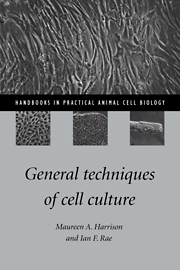6 - Preparation of primary cells
Published online by Cambridge University Press: 02 February 2010
Summary
A primary culture is one started from cells, tissues or organs which are taken directly from an organism. The term primary applies until the culture is passaged for the first time, when it is called a secondary culture. As emphasized previously, at confluence the primary culture will have its closest resemblance to the parent tissue and, for this reason, early passage cells have the advantage that they will not have had time to become dedifferentiated through continuous growth in vitro and should still retain the properties of the parent material. In the case of some cell types, e.g. avian cells, cultures can not be maintained for more than a few passages so that the preparation of primary cultures is necessary.
Primary cultures are obtained either by disaggregating tissue mechanically, this is used most often for cultures where there is little connective tissue present (Wasley & May, 1970), or with the use of enzymes to produce a cell suspension from which some cells will adhere to a suitable surface, or by allowing cells to grow out from tissue explants.
Different tissues may require specialized techniques (see other books in this series), but there are several requirements that will apply to the preparation of most primary cultures.
Embryonic tissues yield more viable cells and grow more rapidly in culture than adult material.
The number of cells seeded per vessel should be of a much higher concentration than would be used for the subculture of an established cell line, as the proportion of cells from the tissue that will survive may be low.
[…]
- Type
- Chapter
- Information
- General Techniques of Cell Culture , pp. 89 - 97Publisher: Cambridge University PressPrint publication year: 1997

